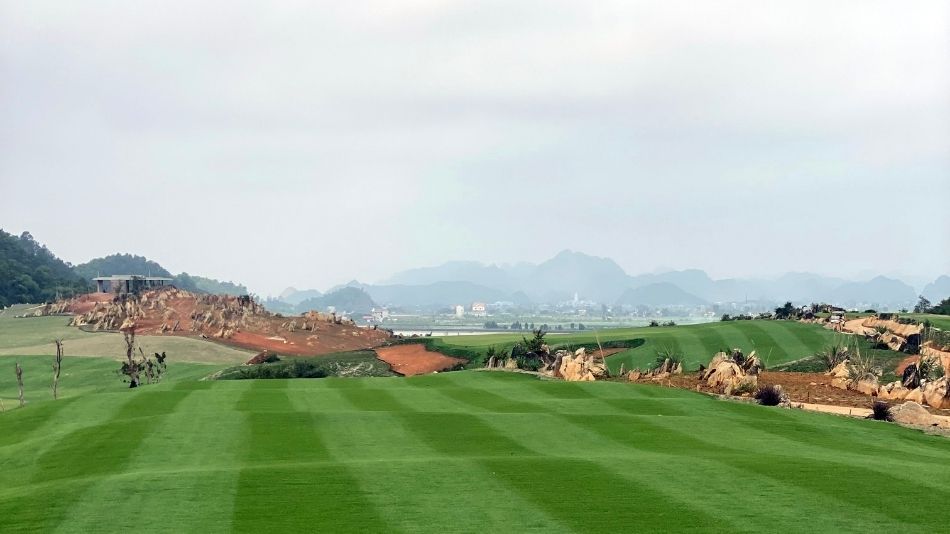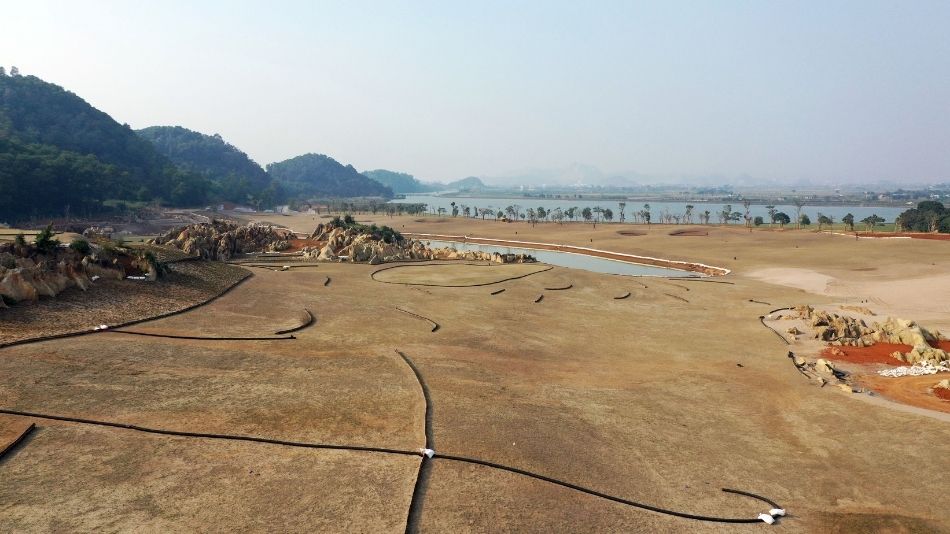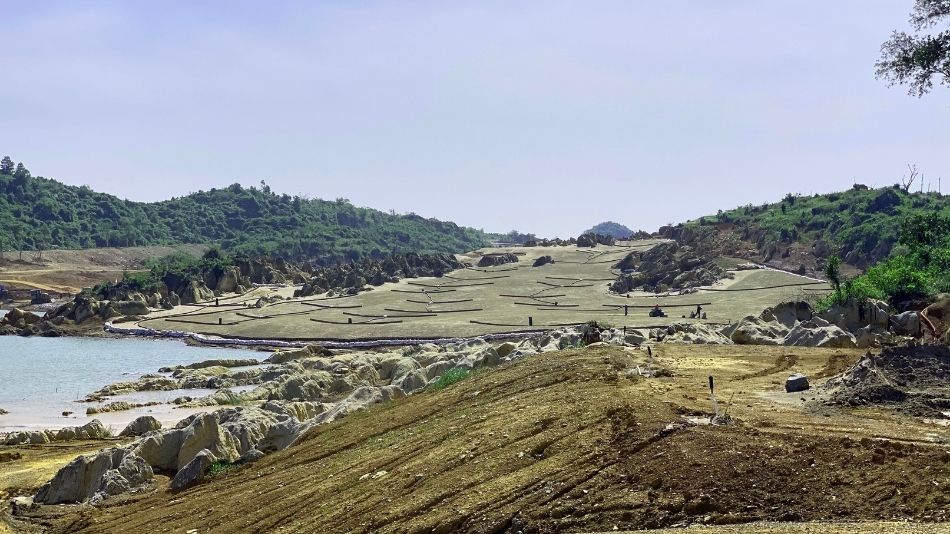Work turns to back nine on new Nicklaus course in Vietnam
Construction work is progressing on a new Jack Nicklaus II golf course at Royal Golf Club near Hanoi, Vietnam.
The Queen’s course will become the second layout at the club, joining the King’s course that was designed by Peter Rousseau.
The front nine of the Queen’s has been grassed and is growing in. Work has now turned to the back nine, with completion expected to be autumn 2021.
“We were fortunate to get holes 12, 13 and 16-18 shaped and moving forward early on in the project, but due to a few hold ups that were out of our control, we are just now diving back into the back nine and its remaining holes that we were unable to work on over the last year,” said Jim Wagner of Nicklaus Design. “The current goal is to have most of 16-18 grassed out by late March and the twelfth and thirteenth holes by mid-April. The tenth and the remaining parts of 17 and 18 should be grassed out in mid to late April as well. The completion of the rest of the back nine is largely dependent on weather and other elements out of our current control.
“The project has progressed fairly well in relation to the pandemic. It actually seems as though the pandemic has had very little impact on actual site progress. As many already know, Vietnam has done a terrific job dealing with the virus. We were also fortunate to get productive site visits in prior to travel shutting down as those visits gave Jack II, shaper Don Page and myself quite a bit of confidence in what we have been creating over the last year during our absence from site.”
With the design team not on site due to the pandemic, they have been keeping track of the project’s progress via virtual means, including daily calls, videos and drone footage.
“We definitely took some risks out there in relation to where we preserved or removed natural rock, as well as a few greensite locations and other features set amongst the natural rock,” said Wagner. “Now that we’ve seen things grow in on the front nine, it’s been rewarding to see those decisions pay off and have the desired impact that we envisioned in terms of playability and aesthetics. It’s also a benefit that we still have plenty of holes to work on, so we can continue to carry out those concepts in other unique ways moving forward. Whether we used the natural rock in place of bunkering or used it to create elevation that sets up a kick slope, we took advantage of the natural rock’s presence as much as possible.”
The Nicklaus team’s use of the site’s natural rock is evident throughout the front nine. “Although the first hole plays around a prominent hillside, encouraging a very advantageous carry over its corner, a good chunk of the front nine – such as holes two and six to nine – play atop a broad ridge that has some smaller valleys and lows within it that have allowed us to set up good visibility throughout each hole.”
Following the opening hole, players will have to climb 15 metres in elevation to the par-three second and play to a green surrounded by natural rock. “There is room to miss short or left, but this tee shot will certainly raise some heart rates,” said Wagner. “The third hole then descends down into a narrow and dramatic valley with natural rock on both sides. The elevation continues to drop along the length of the par-five fourth, before quickly climbing back uphill on the short par-four fifth.
“With all the rock on this side of the property, we don’t have a lot of water on the front nine. The fourth is at the lowest elevation of the property and is the only time water is truly in play on the front nine. Since there is very little rock within that corridor, the fourth happens to have the most bunkers of any of the opening nine holes.”
Wagner says that the front nine is growing in well and there is “terrific variety and some amazing visuals”.
“As for holes that stand out, I would start with the par-four third, which will certainly challenge golfers and provide some wow factor,” said Wagner. “It features an intimidating tee shot with a long ridge of natural rock on the left side that extends into the middle of the landing area about 270-280 yards from the back tees. From there, the fairway widens out on both sides of the ridge giving everyday golfers plenty of room. Since the wind direction can help or hurt you playing down this valley, we’ve created plenty of tee space that will allow the operations team to move the member tees up when the wind is playing in, and back when it’s playing down.
“There are no bunkers on this hole and the green features a really cool feed slope into its front left, which I think many golfers will try to take advantage of considering what we’ve created off the right side of the green. The right side is protected by a long, contoured slope that pulls off the green’s right side. This slope serves as a good example of picking your miss by avoiding it by all means necessary. You could easily find yourself three to four metres below the putting surface depending on how far right you miss. The concepts we’ve implemented around this green really puts our desire to bring the ground game into play and hopefully the Zoysia grass we have selected is set up firm, so the shots play true to what we've envisioned.”
Wagner also points to the par-four fifth with its “stunning setting” and high degree of risk reward as one of the standout holes on the front nine. “The hole is one of the course’s shorter par fours and the approach into the green leaves very little room for error,” he said. “I guess it’s probably one of the few instances where there are not a lot of options hitting into the green as the putting surface is almost set on a cliff with rock framing the right and back right and a bunker protecting its left side before falling off several meters.
“Since there is a bit of elevation change on the approach into the green, the ground game takes a back seat here. Instead, the golfer will have to rely on confidence in their yardages and be extremely careful of the false front staring them in the face. I think what I like most about this hole is the ability for golfers of any skill level to hit a variety of clubs off the tee and leave themselves with what they feel is a comfortable yardage for their approach into the hole’s narrow green.
“I have to also mention the eighth,” continued Wagner. “A long par three that has roughly 100 yards of tee length, so it does have the potential to play short as well. Similar to the third, this long run of tee space is meant to provide the client with the ability to set up the course based on the wind conditions each day. We are back up on the broad ridge at this point in the routing and quite close to the highest elevation on the property. The wind can really blow here! The ability to move the tees based on wind direction in combination with a quasi-Redan-type setup, allows golfers to play to the right of a deep-centre fronting bunker set off the green about seven to eight paces, and to be rewarded with a generous kick to the left and into the green.
“I don’t see many going long here, but it’s certainly possible if the wind is down with firm conditions. Golfers that do go long will be three to five metres below the green and blind trying to save par. The tee shot here is arguably my favourite shot on the front nine and certainly one of the more interesting greens you’ll see in Vietnam. As long as the operations team respects the weather conditions, this hole should stand out nicely and if played correctly by using the feature right of the green to help you, it should be heaps of fun.”
Tees, fairways and rough are being grassed with Zeon Zoysia, while greens have Primo Zoysia.
“We chose Zoysia for its regional adaptability and for its flexibility to a wide variety of weather conditions,” said agronomist Cameron Thompson. “Integral to our philosophy at the Royal Club was producing consistent playing surfaces for member play whilst having the option to elevate to tour-level conditions when required, and at all times adhering to Nicklaus Design standards.
“Furthermore, we were mindful of simplifying agronomic management for the superintendent and envision a long-term commitment to the local environment through a comprehensive sustainability program – the potentially reduced water and fertiliser usage of Zoysia is particularly exciting to us.”
Wagner said: “Seeing the project come together is a nice reminder of the collaborative effort made during the routing process and early field work to maximise the influence the natural rock has on the strategy and setup of golf holes. The added benefits of using the natural rock to our advantage are that we ended up with only 20 bunkers on the front nine and of course, the striking visuals the natural rock provides to the golfing experience on top of the strategic features that were implemented.
“We’ve also been able to create a lot of variety in and around the greens with an emphasis on using interesting ground contours to make golfers put greater focus on where the good misses are in relation to a pin. There’s a lot of options out there and although it can surely play difficult for Vietnam’s and Asia’s best, I think it will also be a fun outward nine for the client and the club’s members and guests.”
| Slideshow HTML |
-

Don Page
The par-three eighth on the Queen’s course, designed by Jack Nicklaus II, at the Royal Club in Vietnam
-

Flagstick Golf Course Construction Management
The par-four third has a long ridge of natural rock on the left side that extends into the middle of the landing area
-

Don Page
Nicklaus Design’s Jim Wagner says the par-four fifth is one of the standouts on the front nine due to its “stunning setting”
|
| ADd Image Credit here for home page | Don Page |